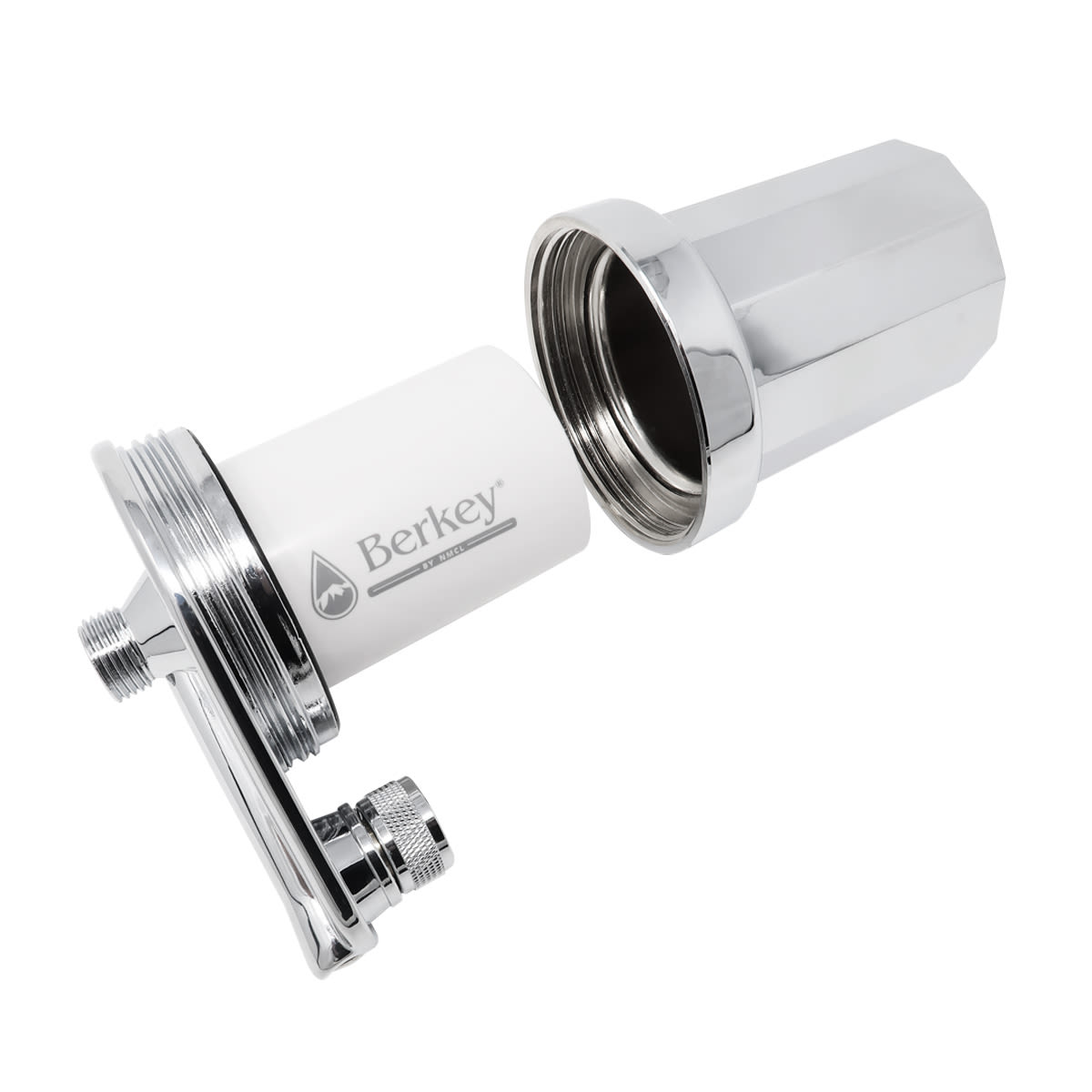FAQs about Berkey Water Purification Systems
I can’t get the chambers of the Berkey Light to snap together, am I doing something wrong?
Please make sure you are aligning the seams, as most of the systems will not snap together unless the seams are aligned. If that doesn't solve the problem, please measure the opening on the lower chamber from seam to seam. The diameter should be at least 20.2 cm. or greater. If it is less than that please contact us.
We would like to spend the least amount of money for a Berkey purification system for meeting the needs of a larger group. What would you recommend?
To determine the optimal size for your situation, please consider that the larger the system's capacity, the less often it requires refilling. All of our systems are available configured with two Black Berkey purification elements however; the four larger stainless steel systems are expandable which means that your first consideration should be to purchase the system, which has the capacity to best meet your group's needs. If at a later date you find that you require more liters per hour, you will not have to invest in another system. You can simply order additional purification elements to expand your current system. Below is a table showing our various two element systems, their capacities and the maximum number of elements each system can accommodate.
| Berkey Model | Capacity | Fully Expanded |
|---|---|---|
| Travel Berkey | 5.7 liter | 2 Elements |
| Berkey Light | 10.4 liter | 4 Elements |
| Big Berkey | 8.5 liter | 4 Elements |
| Royal Berkey | 12.3 liter | 4 Elements |
| Imperial Berkey | 17 liter | 6 Elements |
| Crown Berkey | 22.7 liter | 8 Elements |
What are the basic differences between the Berkey Light and the other stainless steel systems?
The Berkey Light system is designed for outdoor use therefore it is about three pounds lighter in weight than the equivalent capacity of our stainless steel system. The Travel Berkey system is also designed for outdoor use and is the smallest of the stainless steel systems. It is compact enough to fit within a suitcase because unlike the Berkey Light system, the upper chamber nests within the lower chamber during travel. This is the preferred system when mobility is a big issue. So it depends on what kind of portability you are looking for; lighter weight (Berkey Light) or compactness (Travel Berkey).
The four-multi use systems are designed for indoor everyday use so they are of a heavier construction than the above systems. Although these systems can also be used outdoors or during unexpected emergencies when a source of potable water may not be available.
What is the most convenient method for filling the upper chamber?
Most people use a pitcher to pour water into the upper chamber. Another convenient method is if you refill using a spray hose attached to your kitchen faucet.
The water in the upper chamber of my Berkey filter system does not drain all the way. Is this normal?
Yes it is normal and not unusual for the last 1.3 cm. to 2.5 cm. of water to remain in the upper chamber. By design the water must pass through very fine micro pores within the elements in order to pass from the upper chamber to the lower. The lower the water level in the upper chamber, the lower the pressure available to force the water through the micro pores. You may have noticed that the system purifies much faster when full than when half full. That's because there is more water pressure. The only way to remedy this problem would be to enlarge the pores of the filter elements. This would of course, reduce the efficiency of the Berkey purification elements. During each cycle the water left from the previous cycle mixes with the water from the current cycle and is then purified. There is no need to be concerned about the excess water during normal use. Should you however discontinue using your filter for a period of time such as during a vacation, it would be best to empty both chambers before departing and leave them upside down to dry on the dish rack.
I have been using my system for about six months and the flow rate has slowed down considerably. Do I already need to replace the elements?
No, unlike other filtration elements Black Berkey purification elements are re-cleanable. What typically causes the filters to drip slowly is turbidity and sediment clogging the micro-pores of the purification elements. Simply remove the elements from your system, scrub the exterior of each element with preferably a white ScotchBrite pad, stiff toothbrush or vegetable brush. Simply scrub a section of the filter until you see a bit of black on the white pad then move to the next section. It’s simple to do and takes less than a minute. Then re-prime each element and reinstall them. Your problem should now be fixed.
How do I know when it is time to replace the elements in my system?
The best way to ascertain when to replace the filters is to use our calculator below, alternatively you can perform the following calculation manually:
- Multiply the number of filters in your system by 11,350 liters to get Total Liters For All Filters within the system.
- Next keep track of how many times you need to refill the upper chamber in one week.
- Then multiply that figure times the capacity in liters of your particular system (for example the Berkey Light system is 10.4 liters) to determine Total Liters Used Per Week.
- Finally divide the Total Liters Used Per Week into the Total Liters For All Filters and that will tell you how many weeks before the filters should be replaced.
- Next calculate the future date for replacement (52 weeks per year) and write that date on a sticker and attach it to the bottom of your system for future reference.
By the way, if you have been using your system for some time now, you can still use the above formula to determine when to replace the elements. Just count forward from the date you purchased your system.
Black Berkey Filter Replacement Calculator
I will soon be travelling to a foreign country. Is there a way to test my Berkey® system to make sure it is working properly before I leave?
Yes, anytime you plan on taking your system to foreign shores we advise that you always perform the following test prior to leaving. You should test your filters by filling the upper chamber with water then adding a teaspoon of red food coloring for every 4 liters of water within your upper chamber. If the red food coloring is removed entirely, your filtration system is working properly. If not, check to make sure that the wing nuts on your elements are securely tightened, then re-run the test. By the way, always prime new purification elements before leaving the country, as you may not have enough water pressure to be able to prime the elements at your destination.
I just purchased a Berkey system but the system is hardly filtering any water at all. Am I doing something wrong?
Usually the problem you are experiencing is due to high water tension, which prevents the air from being purged from the micro pores of the new purification elements. Included with your Black Berkey filter elements is a priming button and instructions for their use. Please remove and prime your purification elements, reinstall them and that should repair the problem.
I have found that when I boil the water or freeze it into ice cubes, I sometimes get little white floating things in the water. What are these white floating things? Bacteria?
They are not bacteria, but rather an effect that sometimes happens with hard (heavily mineralized) water. When water is filtered through your system, the Black Berkey filter elements actually increase the PH (alkalinity) of the water. This is healthful as pathogenic bacteria and viruses thrive in acidic environments and on the contrary have difficulty surviving in alkaline environments. This is also the case inside your body. When the PH level of the purified water is raised, the acidity of the water goes down and the water is no longer able to hold as many minerals in solution. When this happens the minerals begin to precipitate out over time and depending on the mineral composition they will either sink to the bottom or float to the top. This process is known as flocculation and the precipitated minerals are usually referred to as "white floaters". The bottom line is that this is nothing to be concerned about, the white floaters are minerals that were already in solution in your water. They are now simply visible whereas they were previously invisible due to their suspension in an ionic form.
I did a TDS reading on the purified water and was surprised to find that the reading was about the same with the purified water as it was with the unpurified water. Is my system working properly?
Yes, a TDS meter measures only Total Dissolved Solids or minerals; dissolved solids are simply dissolved minerals in an ionic form. A TDS meter does not measure the amount of biological and chemical contaminates. Black Berkey elements are designed to leave the healthful and beneficial minerals in your water and to extract only the unwanted heavy metals such as lead and mercury as well as sedimentary minerals such as iron oxide and aluminum.
Is there a Berkey purification system that will accommodate large groups?
Yes, there are two systems to meet the needs of large groups:
- The Imperial Berkey system, when configured with six Black Berkey filter elements can purify up to 1514 liters per day(~64 liters per hour)when the upper chamber is full. This is enough to provide for up to 200 people on a sustained basis and up to 800 people on a short-term emergency basis.
- The Crown Berkey system, when configured with eight Black Berkey filter elements can purify up to 2460 liters per day (~102 liters per hour) when the upper chamber is full. This is enough to provide for up to 325 people on a sustained basis and up to 1,300 people on a short-term emergency basis.
What are the Blocking Plugs made of?
There are three different types of Blocking Plugs:
- Black blocking plugs come standard in all Berkey Light systems and some stainless steel systems. The black plugs are made of FDA approved Buna rubber.
- Cream colored blocking plugs may come with the Berkey Light and some stainless steel systems. The cream colored plugs are made of food grade M18 pure gum rubber.
- White screw-type blocking plugs are used in some stainless steel systems. These come with a nut, a screw and two clear washers. The nut and screw are made of polypropylene and the washers are made of food- grade silicone.







